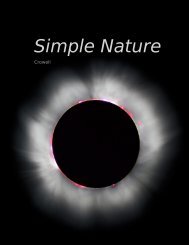The size of a radio antenna is closely related to ... - Light and Matter
The size of a radio antenna is closely related to ... - Light and Matter
The size of a radio antenna is closely related to ... - Light and Matter
You also want an ePaper? Increase the reach of your titles
YUMPU automatically turns print PDFs into web optimized ePapers that Google loves.
system, velocities are always unitless. Th<strong>is</strong> sort <strong>of</strong> thing happens<br />
frequently in physics. For instance, before James Joule d<strong>is</strong>covered<br />
conservation <strong>of</strong> energy, nobody knew that heat <strong>and</strong> mechanical energy<br />
were different forms <strong>of</strong> the same thing, so instead <strong>of</strong> measuring<br />
them both in units <strong>of</strong> joules as we would do now, they measured<br />
heat in one unit (such as calories) <strong>and</strong> mechanical energy in another<br />
(such as foot-pounds). In ordinary metric units, we just need an<br />
extra conversion fac<strong>to</strong>r c, <strong>and</strong> the equation becomes<br />
1<br />
γ = √<br />
1 − ( )<br />
.<br />
v 2<br />
c<br />
k / <strong>The</strong> γ fac<strong>to</strong>r.<br />
Here’s why we care about γ. Figure k defines it as the ratio <strong>of</strong> two<br />
times: the time between two events as expressed in one coordinate<br />
system, <strong>and</strong> the time between the same two events as measured in<br />
the other one. <strong>The</strong> interpretation <strong>is</strong>:<br />
Time dilation<br />
A clock runs fastest in the frame <strong>of</strong> reference <strong>of</strong> an observer<br />
who <strong>is</strong> at rest relative <strong>to</strong> the clock. An observer in motion<br />
relative <strong>to</strong> the clock at speed v perceives the clock as running<br />
more slowly by a fac<strong>to</strong>r <strong>of</strong> γ.<br />
l / <strong>The</strong> ruler <strong>is</strong> moving in frame<br />
1, represented by a square, but<br />
at rest in frame 2, shown as a<br />
parallelogram. Each picture <strong>of</strong><br />
the ruler <strong>is</strong> a snapshot taken<br />
at a certain moment as judged<br />
according <strong>to</strong> frame 2’s notion<br />
<strong>of</strong> simultaneity. An observer in<br />
frame 1 judges the ruler’s length<br />
instead according <strong>to</strong> frame 1’s<br />
definition <strong>of</strong> simultaneity, i.e.,<br />
using points that are lined up<br />
vertically on the graph. <strong>The</strong> ruler<br />
appears shorter in the frame in<br />
which it <strong>is</strong> moving. As proved<br />
in figure m, the length contracts<br />
from L <strong>to</strong> L/γ.<br />
m / Th<strong>is</strong> figure proves, as claimed in figure l, that the length contraction<br />
<strong>is</strong> x = 1/γ. First we slice the parallelogram vertically like a salami<br />
<strong>and</strong> slide the slices down, making the <strong>to</strong>p <strong>and</strong> bot<strong>to</strong>m edges horizontal.<br />
<strong>The</strong>n we do the same in the horizontal direction, forming a rectangle with<br />
sides γ <strong>and</strong> x. Since both the Lorentz transformation <strong>and</strong> the slicing<br />
processes leave areas unchanged, the area γx <strong>of</strong> the rectangle must<br />
equal the area <strong>of</strong> the original square, which <strong>is</strong> 1.<br />
As proved in figures l <strong>and</strong> m, lengths are also d<strong>is</strong><strong>to</strong>rted:<br />
Length contraction<br />
A meter-stick appears longest <strong>to</strong> an observer who <strong>is</strong> at rest<br />
relative <strong>to</strong> it. An observer moving relative <strong>to</strong> the meter-stick<br />
at v observes the stick <strong>to</strong> be shortened by a fac<strong>to</strong>r <strong>of</strong> γ.<br />
self-check A<br />
What <strong>is</strong> γ when v = 0? What does th<strong>is</strong> mean? ⊲ Answer, p. 924<br />
390 Chapter 7 Relativity














